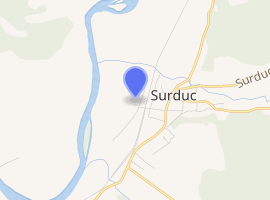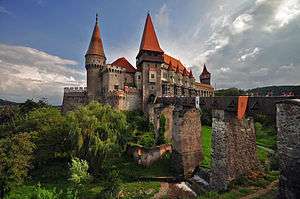Jósika Castle
The Jósika ['yɔ:şikɔ] domain in Surduc, a village in Sălaj County, Romania, consists of a low-rise castle on the left bank of Someș River and a crypt built on a steep cliff at the entrance from Jibou into the village. The crypt, locally known as "Baron's crypt" (Romanian: Cripta baronului), was built in 1825, in the memory of Miklós Jósika's father who died a year before. On the facade can be read "Parenti optimo pietas proculium posuit ano. MDCCCXXVII-mo", an inscription executed in 1828 by Hirschfeld Friedrich, a sculptor born in Debrecen.[2]
| Jósika Castle | |
|---|---|
Castelul Jósika (in Romanian) Jósika kastély (in Hungarian) | |

| |
| Former names | Csáky Mansion |
| Etymology | Jósika family |
| General information | |
| Status | Deteriorated |
| Type | Castle |
| Architectural style | Classicist |
| Location | 334, Surduc, Sălaj County, Romania[1] |
| Coordinates | 47.25597°N 23.3411522°E |
| Construction started | 17th century |
| Completed | 19th century |
| Owner | Csáky family (1641–1810) Kemény family Jósika family (1810–1853) Agromec (nowadays) |
| Technical details | |
| Material | Stone |
| Other information | |
| Number of rooms | 17 |
Here lived and worked from 1824 until 1853, writer Miklós Jósika, founder of the Hungarian romantic novel. Between the walls of the castle, he wrote the historical novel "Abafi", his style being likened to Walter Scott. Members of Jósika family, originating in the north of the current Hunedoara County,[3] contributed significantly to the rise and final appearance of the castle.[4]
It is important from a historical perspective, because here Prince of Transylvania Francis II Rákóczi served a last lunch with Csáky István before the battle of Zsibó (today Jibou) of November 15, 1705, lost to the Austrian imperial army led by General Ludwig von Herbeville.[5]
The castle is included in the List of Historical Monuments elaborated by the Ministry of Culture, as monument of local importance.
History
In the 17th century, Surduc, and hence the mansion, were property of Csáky family.[6] From their mansion built in the middle of a park has not been preserved but the house of the servants. The mansion was turned into castle probably in the 18th century, because in the early 19th century the building is already registered as castle. In 1810 becomes the property of Jósika family.
Maternal grandmother of Hungarian writer Miklós Jósika was a descendant of Csáky family. An inventory from 1854 records a building consisting of 17 rooms, including the writer's bureau and a chapel.[6] The castle was built with stone from the nearby Roman castra of Tihău.[7]
The castle had a park where subsequently were found several fountains and a statue of Maria Theresa. The stone lions from the park were sent to the Wesselényi Castle of Jibou in the 1970s. On the main alley, there is a baroque church, and the main salon of the castle was full of remarkable pictures. The pieces of furniture were hand-carved, and the chandeliers surprised by elegance and refinement.
Establishment of the communist regime in Romania led to the transformation of the castle into the headquarters of Station for Mechanization of Agriculture.[8] Many valuable pieces here have disappeared or were destroyed.
References
- "Castelul Jozsika, azi Agromec". Monumentele Istorice din România (in Romanian).
- "Surduc, Cripta familiei Jósika". Welcome to Romania (in Romanian).
- "Castelul Jósika din Surduc". InfoPensiuni.ro (in Romanian).
- "Castelul Jósika". TuristGhid.ro (in Romanian). Archived from the original on 2014-12-11. Retrieved 2014-12-11.
- "Sălajul turistic - Cripta familiei Jósika din Surduc". Foto travel (in Romanian). 30 October 2012.
- "Surduc, Castelul Jósika". Welcome to Romania (in Romanian).
- Dumitru Protase. "Castrul roman de la Tihău (jud. Sălaj) în lumina cunoștințelor actuale" (PDF). Institute of Archaeology and Art History of the Romanian Academy (in Romanian).
- "Archived copy". Archived from the original on 2014-12-13. Retrieved 2014-12-11.CS1 maint: archived copy as title (link)
